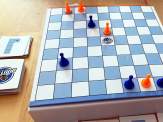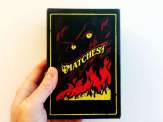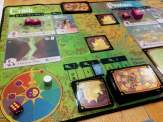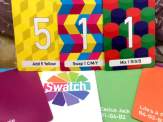| Release Date: 2026 | Players: 2 (only) |
| Designer: Chris Priscott | Length: 15-30 minutes |
| Artist: Chris Priscott | Age: 10+ |
| Publisher: Unfringed | Complexity: 1.5 / 5 |
| Plastic (by weight): <1% | Air (by volume): <10% |
It was like there were pixels: red ones, blue ones and black ones. There was one, two, three or four for each, sometimes none, in all sorts of combinations. You could combine them to give you five, six, seven or eight in the different colours. It was a real puzzle. You wanted to create the lowest or highest difference between the numbers in the centre and those in your hand. That difference changed over time. It was D.O.T by Chris Priscott from Unfringed.
Listen to the Audio Version
Intro Music: Bomber (Sting) by Riot (https://www.
Music: “analogs” provided by mobygratis.
Music: “i believed inst” provided by mobygratis.
Music: “disto1” provided by mobygratis.
A Simple Premise and a Simple Start
D.O.T has a deceptively simple premise. Play cards so that the difference of the dots in the three different colours on the cards in the centre and your cards is the lowest or highest, depending on the round. It’s not difficult at all.
But let me start at the beginning…
Each player receives an identical deck of eighteen cards and three star cards. Each round, players draw five cards from their shuffled deck and select one of their three star cards. They choose three of the six cards to be played into a shared pool in the centre and keep the other three for themselves. Each card shows a combination of zero to five red, blue and black dots, which are actually little shapes to make them easier to distinguish. If you’re colour blind, the location and shape of the dots tells you what colour they are.
The goal is to create either the lowest or highest difference, depending on the current round, between the dots of each colour in your hand and those in the centre, which the other player added three of their cards to. You repeat this two more times, clearing out the central pool of cards each time, but leaving your cards in front of you. It sounds simple enough, but it creates a really clever logic puzzle.
Both players’ decks are symmetrical. So aside from the randomness of the card shuffle, both players start on equal footing. In the first round, you don’t have much to go on. All you can do is split up your six cards in the best way you can, and hope that your opponent can’t mess too much with the outcome. At this stage, the pressure of making the right choices is quite low.
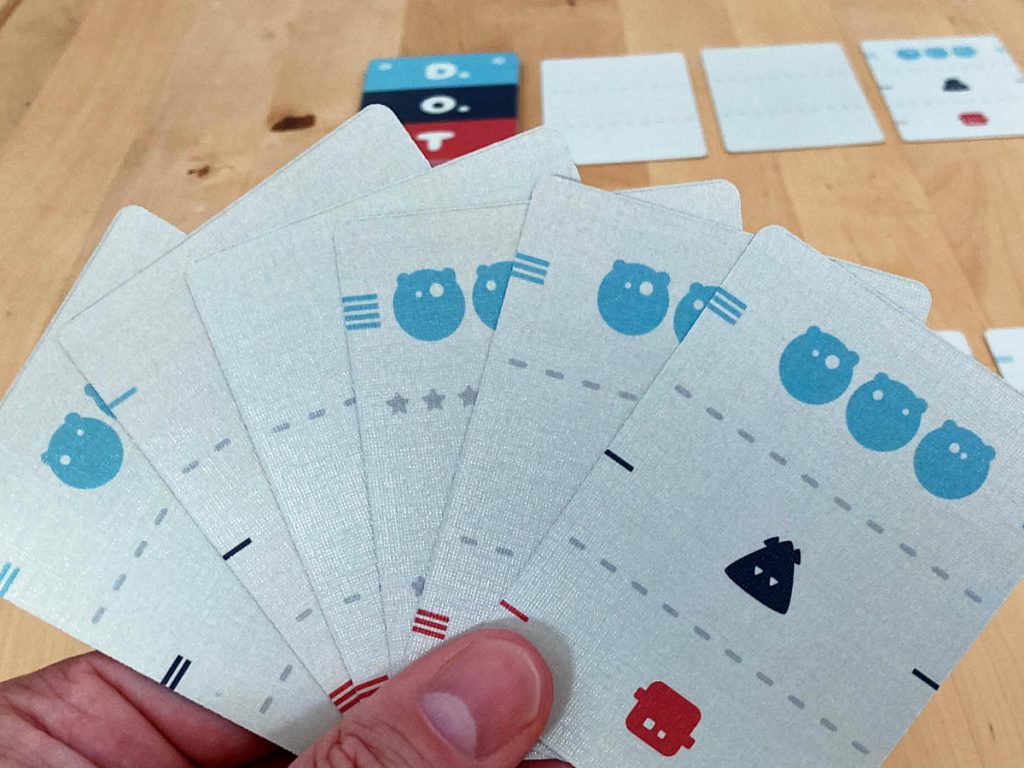
Connecting the D.O.Ts
However, in the second round, you have more information. You know what cards have been played. That allows you to make a rough estimate as to what your opponent’s options are and what you should do with the cards you drew. Suddenly, every card carries more weight. Your only real tactical joker is the star cards, which contain four dots of a single colour, and which you can freely choose. Even so, they require careful timing. Placing a star card at the wrong time in the hope of getting a win can be wasteful, but leaving it too late can also be pointless.
What makes D.O.T interesting is that cards are carried over between rounds. That means a bad decision early on can make matters worse later. You realise that every choice will ripple into the future. It gives D.O.T a deck-building game twist.
Don’t forget though that every round you have more information.
In theory, in the last round, you know exactly what everyone has. That’s in some ways a shame. I usually hate games where you have to remember things. I always feel that there should be no need to remember information that was previously revealed. It should just remain public.
However, there are exceptions to this, of course. Dune is one, and D.O.T is another. In Dune, information is valuable and can be used as leverage for some factions. In D.O.T, not necessarily being 100% sure what cards your opponent has creates tension and excitement. Otherwise, the game’s last round would be boring and merely a matter of mathing out the best combination of what cards to place where. As it is, you need to take a risk and go with your gut.
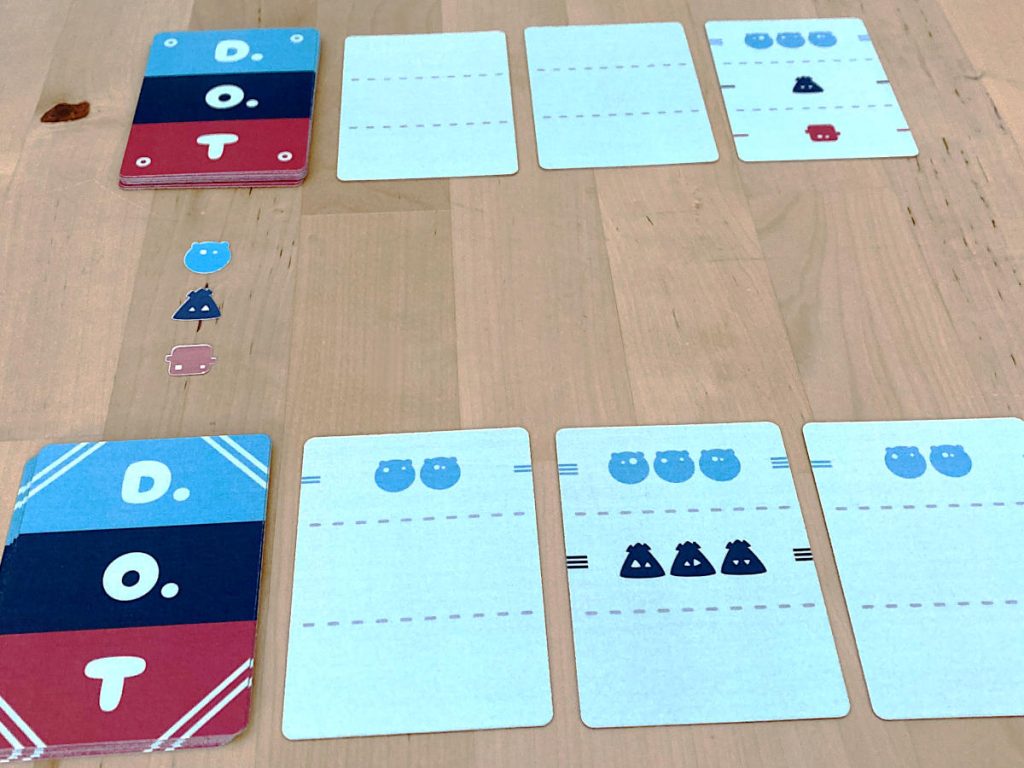
Ties, Timing and Tension
Another interesting aspect is tied scoring. When players are tied, the scoring token from that round carries over to the next. That allows players to intentionally aim for ties when winning a specific colour feels impossible. You can try to position yourself for a potential future advantage and score more points in the next round. That introduces tactical depth without complicating the rules.
D.O.T is also really compact. It’s a deck of cards and some tokens, plus some really simple rules. I only played a prototype of the game, so I can’t properly comment on the components, but by the looks of it, the scoring tokens will be really tactile, and the card stock should be of good quality. The artwork is simple, but that’s very fitting for such an abstract game.
If you put it all together, you get a game that blends planning and memory into a really fun and tense gameplay experience that you can take with you in your coat pocket. Card counting may feel taxing, but it’s critical to keep the tension and player engagement. The mental space that D.O.T requires is just at the right level to produce a rich duel that remains engaging across three rounds, without being overly taxing.
D.O.T demonstrates how a well-designed abstract game can be extremely elegant. It shows that even the most minimalist of designs can produce deep engagement. For two players who appreciate abstract strategy and deduction, it offers a tight, intelligent duel. D.O.T is clever, elegant, and highly satisfying, a game where every card matters and every decision shapes the unfolding duel.
Keeping the blog running takes time and resources. So if you can chip in, that would be amazing.
Useful Links
- D.O.T: https://unfringed.
co/ dot/ - Kickstarter page: https://www.
kickstarter. com/ projects/ unfringed/ fetching-feathers - Unfringed: https://unfringed.
co/ - BGG listing: https://boardgamegeek.
com/ boardgame/ 451061/ dot - Dune review: https://tabletopgamesblog.
com/ 2020/ 02/ 08/ dune-saturday-review/
Transparency Facts
- I was given a free review copy of this game by the publisher.
- At the time of writing, I have not received financial support from the publisher or anyone working on their behalf.
Audio Version
Intro Music: Bomber (Sting) by Riot (https://www.
Music: “analogs” provided by mobygratis.
Music: “i believed inst” provided by mobygratis.
Music: “disto1” provided by mobygratis.
Playlist
These are the songs I listened to while I was writing this review:



